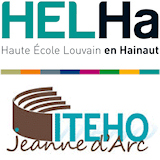Centre de Documentation HELHa Tournai - Mouscron
Heures d'ouverture (période scolaire)
| Tournai | Mouscron |
| - lundi : 9h00-12h00 et 13h00-17h00 - mardi: 9h00-12h30 et 13h00-17h00 - mercredi: 9h00-12h30 et 13h00-17h30 - jeudi: 9h00-12h30 et 13h00-17h00 - vendredi: 09h00-17h00 | - lundi: 9h00 à 12h30 et 13h00 à 17h15 - mardi: 13h00 à 17h15 - mercredi: 13h00 à 17h15 - jeudi : 13h00 à 17h15 - vendredi: 13h00 à 17h00 |
Semaine du 30/06 à Tournai : Fermé mardi jusque 14h15
Semaine du 07/07 à Tournai : Horaire aménagé : Ouvert lundi 07/07 de 13h00 à 16h30, mercredi 09/07 de 13h00 à 16h30.
Semaine du 25/08 à Tournai : Reprise des activités. Lundi 25/08, ouvert de 9h00 à 12h00 (Réunion de l'équipe pédagogique, l'après midi).
Semaine du 30/06 à Mouscron : Horaire habituel
Semaine du 07/07à Mouscron :
Semaine du 25/08 à Mouscron :: Ouvert le lundi.
Notre catalogue possède un thésaurus (voir ci-dessous : catégories). Pour effectuer une recherche structurée, nous vous conseillons de cliquer sur la "recherche multi-critères". Dans le menu déroulant, descendez et choisissez "Indexations - Catégories", tapez votre descripteur (mot-clé) et sélectionnez-le lorsqu'il apparaît. Pour introduire un 2è terme, renouvelez l'opération (ET). Vous pouvez élargir les résultats en ajoutant des termes proches avec + (OU).
Détail de l'auteur
Auteur E. Bonadeo |
Documents disponibles écrits par cet auteur


 Ajouter le résultat dans votre panier Affiner la recherche
Ajouter le résultat dans votre panier Affiner la recherchePrévention des légionelloses nosocomiales par une meilleure gestion de l'eau : comparaison de trois méthodes de décontamination / A. Muzzi in Hygiènes, Vol. XXIX, n°3 (Juillet 2021)
Titre : Prévention des légionelloses nosocomiales par une meilleure gestion de l'eau : comparaison de trois méthodes de décontamination Type de document : texte imprimé Auteurs : A. Muzzi, Auteur ; E. Bonadeo, Auteur ; S. Cutti, Auteur ; et al., Auteur Année de publication : 2021 Article en page(s) : 227-230 Langues : Français (fre) Catégories : Alpha
D:Décontamination ; E:Eau ; I:infection associée aux soins ; L:Légionnaire maladieRésumé : Background :
Since 2000, the National Health System has adopted international guidelines for assessing Legionella spp. In hospital water systems. The control of water contamination by Legionella spp. is still a matter of research concerning the most effective method in preventing nosocomial infection. Aim. To compare three different decontamination methods by monitoring colony-forming unit count and number of hospital-acquired legionellosis cases. A secondary objective was to evaluate the long-term effects of the preventive measures on the water pipes.
Methods :
A protocol was developed for the selection of high-risk sampling sites and for the testing of three disinfecting methods over the course of 19 years: hyperchlorination and thermal shock (period A, 2000-2005) ; copper-silver ionization (period B, 2006-2010) ; and integration of pre-filtering, filtering, pipe-protection products, and remote control with chlorine dioxide (ClO2)(period C, 2011-2018).
Findings :
The use of shock disinfection and hyperchlorination led to a decrease in contamination level immediately after the procedure, but then it rose again to the previous level in two months. Both copper-silver ionization and ClO2 showed a stable and durable decrease in contamination level. Throughout these three phases, six cases of Legionella spp. occured during period A, six cases during period B, and three cases during period C. With regard to the damage of water pipes, effective copper-silver levels caused corrosion and calcification in water pipes.
Conclusion :
Both copper-silver ionization and ClO2 properly controlled Legionella spp. contamination. ClO2 significantly reduced the number of positive sites (P<0,001) without damaging the pipelines. (Source éditeur)Permalink : http://cdocs.helha.be/pmbtournai/opac_css/index.php?lvl=notice_display&id=48648
in Hygiènes > Vol. XXIX, n°3 (Juillet 2021) . - 227-230[article] Prévention des légionelloses nosocomiales par une meilleure gestion de l'eau : comparaison de trois méthodes de décontamination [texte imprimé] / A. Muzzi, Auteur ; E. Bonadeo, Auteur ; S. Cutti, Auteur ; et al., Auteur . - 2021 . - 227-230.
Langues : Français (fre)
in Hygiènes > Vol. XXIX, n°3 (Juillet 2021) . - 227-230
Catégories : Alpha
D:Décontamination ; E:Eau ; I:infection associée aux soins ; L:Légionnaire maladieRésumé : Background :
Since 2000, the National Health System has adopted international guidelines for assessing Legionella spp. In hospital water systems. The control of water contamination by Legionella spp. is still a matter of research concerning the most effective method in preventing nosocomial infection. Aim. To compare three different decontamination methods by monitoring colony-forming unit count and number of hospital-acquired legionellosis cases. A secondary objective was to evaluate the long-term effects of the preventive measures on the water pipes.
Methods :
A protocol was developed for the selection of high-risk sampling sites and for the testing of three disinfecting methods over the course of 19 years: hyperchlorination and thermal shock (period A, 2000-2005) ; copper-silver ionization (period B, 2006-2010) ; and integration of pre-filtering, filtering, pipe-protection products, and remote control with chlorine dioxide (ClO2)(period C, 2011-2018).
Findings :
The use of shock disinfection and hyperchlorination led to a decrease in contamination level immediately after the procedure, but then it rose again to the previous level in two months. Both copper-silver ionization and ClO2 showed a stable and durable decrease in contamination level. Throughout these three phases, six cases of Legionella spp. occured during period A, six cases during period B, and three cases during period C. With regard to the damage of water pipes, effective copper-silver levels caused corrosion and calcification in water pipes.
Conclusion :
Both copper-silver ionization and ClO2 properly controlled Legionella spp. contamination. ClO2 significantly reduced the number of positive sites (P<0,001) without damaging the pipelines. (Source éditeur)Permalink : http://cdocs.helha.be/pmbtournai/opac_css/index.php?lvl=notice_display&id=48648 Exemplaires
Code-barres Cote Support Localisation Section Disponibilité aucun exemplaire








